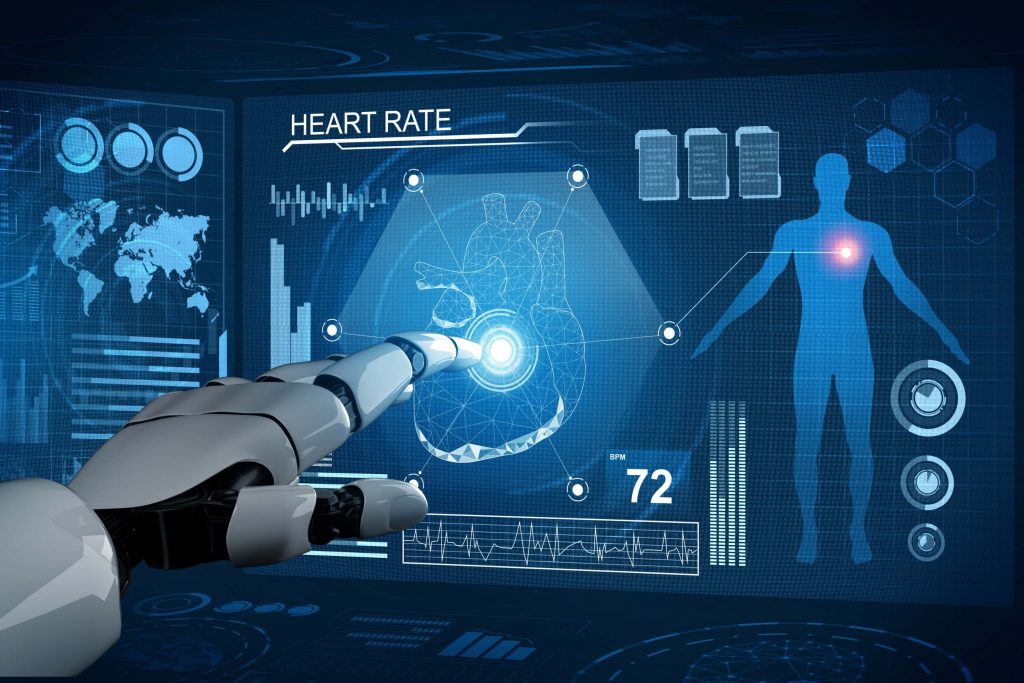
Machine Learning is the new trending concept that is revolutionizing a lot of sectors already. To start understanding the use cases of the technology or more precisely the mechanism, we need to form a brief understanding of it.
What is Machine Learning?
In a nutshell machine learning is the capability of the computers to collect, observe, and process the data provided to it without much human interference. It’s a comprehensive concept, but if I had to put it in a sentence then, “Machine learning enables computers to automate experiences by generalizing examples and figuring out important tasks”.
Research in the field continuously provides improved results. Now, this happens because of the tendency to discover limitations and boundaries to the existing methods; and researchers consistently try to improve the current trends, with the assistance of the developers.
Machine learning quickens the segregation and grouping of data, which would cost immense time if executed by humans. ML softwares is capable of finding patterns in big data and highlighting them, which would cause errors/neglected by the human eye.
Machine learning algorithms consist of:
Representation (a set of classifiers or the language that a computer understands), Evaluation (objective/scoring function), Optimization (search method; often the highest-scoring classifier).
The machine learning algorithms are grouped in many forms as the basis of differentiation is vast. These algorithms have been incorporated across various sectors having many potential uses. The use case of machine learning can be actively seen in customer service, forecasting, product recommendation, healthcare, etc.
Use cases in various sectors
Voice assistants
The brain behind SIRI, Google Assistant, or Cortana is machine learning. The machine learning algorithms that are put into use while constructing voice assistants are integrated with Natural Language Processing (NLP). These voice assistants are trained to recognize human voices, consequently convert them into numbers, and then finally come up with an instant response. These assistants often generalize our tasks and its responses based on our habits and applications.
We often do not contemplate the complexity of the mechanism that goes after “Okay Google”, but it sure has made our lives much more comfortable, and quick.
Travel
The first exciting use case in the travel industry is the dynamic pricing tool which is most often implemented by travel agencies. How cumbersome, and tiring would the process get if the human operators have to customize the prices according to the market conditions(how far is the travel date. How many travels are in demand, etc.) every time. The good news is that through ML, they don’t have to beat their heads about this and can focus on the more essential things.
Another use case of ML is when you type the destination, and Google Maps shows you the best route for your travel. This use case is also really beneficial to the cab companies, who rely on this mechanism to get more rides per day.
The recent innovation of self-driven cars is also a good use case for ML. The cars recognize traffic signals, passengers, forgoing objects, speed, based on the algorithms of machine learning.
Mails and Media
Do you know how all the spam mails et collected automatically in the spam folder, without you requiring to justify the same? It is because of ML, what it mostly does is, assess the similarity of such emails, and group them so that your inbox is filtered.
Additionally, all the social media platforms use this mechanism to avoid any explicit, violent, and offensive content of their sites. So it is not a human employee telling the users that ‘this content cannot be published’, it’s the computers who recognize the content based on the generalized similarities and generate the message.
Product Recommendations
When you have searched for a particular product, say on Amazon, your Instagram, Facebook, chrome screens are fille with the recommendations of that/and similar products, this is the work of AI.
It makes sales and marketing customized and helps to get the attention of the target audience. A similar thing happens when you get the friend recommendations on Facebook, Instagram, LinkedIn, etc. Again the ML algorithms observe patterns and learn from them to provide similar and focused results to you.
Personal Marketing
How did sales happen traditionally? You probably would find somebody at your door selling products that are of no use/interest to you or the companies spamming your calls convincing you to buy their products and services, right? And now you get personalized offers based on your purchase history, the tabs that you search often, and the applications you use. So for example, if you have lately been researching a lot about AI, you’ll get mails/texts offering you courses related to it. This is very efficient since it optimizes the time and cost of the providers and customers.
Security
The undeniable use case of this is surveillance cameras. Countries, organizations all over the world are using these algorithms to keep track of their citizens and employees. The new update in iOS notifies you, who is standing at your door, based on the faces tagged in your photos. All this is the work of Artificial Intelligence and Machine Learning.
Process Automation
Businesses incorporate various processes that can be integrated with machine learning to provide better and improved results. These processes include demand forecasting, customer-loyalty analysis, optimization, etc. In this competitive world, you need to stand out and be faster. ML is your gateway for this. Tasks that require months to be completed manually can be achieved within days with ML,
Banking
The financial sector has already gained a lot of benefits from blockchain technology. Starting with Bitcoin, advancements in AI have led to a revelation in the financial industry. Almost all the significant transactions take place through banking. The computers have inputs about the standard patterns. When the computer recognizes high discrepancies in the data, it notifies them of the errors; this helps the banking to detect any fraudulent practices/scams. The cybercrimes keep on exceeding the stages and finding glitches in the system.
Consequently, developers thrive on making the system more accurate and improved. Another application of ML in the banking sector is personalization. Now we are well aware of what personalization is, the banking services get more focused on the segments that you’re inclined to and offer various options of investment, etc.
Top 4 Use Cases in Healthcare
Machine learning in the healthcare sector helps improve decision-making, optimized innovation, improved efficiency of research/clinical trials, and new tool creation for physicians, consumers, insurers, and regulators. Research and Development in Healthcare are directed towards identifying the risk of developing sepsis and diagnosing breast cancer.
These have to be carefully planned and implemented so that it helps the patients and brings returns on investment. Using open-source data sciences, developers can build systems in such a way that it addresses the requirements of the healthcare sector and improves patient’s conditions. Here are four machine learning use cases for the healthcare sector that can be developed with open-source data science tools and adapted for different functions.
1. Patient- Risk Identification
Machine learning models have several advantages over classic linear models when it comes to patient-level predictions that are important in a value-based care framework. Provider organizations can use machine learning models to help identify the members who would benefit most from active care management to improve patient outcomes and reduce costs under value-based contracting.
Advances in machine learning, particularly in the healthcare sector have helped the doctors across the globe to use algorithms to detect patterns and subsequently predict heart attacks, sepsis, and diseases. If doctors are aware of the condition beforehand, they can start taking preventive measures and practice risk management. The Sepsis Sniffer Algorithm uses demographic signals to alert the individual staff whenever the risk of developing the disease increases. This algorithm was developed by Mayo Clinic and has decreased the manual screening time by 72%.
Another such example is El Camino Hospital. Their researchers used electronic health records, bed alarm data, and nurse call data to develop a tool for predicting patient falls. This new tool alerts staff when a patient is at high risk for falling so they can take action to reduce the risk. They managed to reduce falls by 39%.
2. Oncology
Deep learning can be customized to algorithms that can identify early development of tumours in the lungs, breasts, brains, etc. This happens because the algorithms cn=an be designed to provide information about the patterns in patients and the development of the disease and alert an early detection. Algorithms can be trained to recognize intricate patterns in radiographic imaging data. Researchers all over the world have tried to benefit from these tools to detect essential features from gene expression data, to identify brain cells of breast cancer. Houston Methodist Research developed such a device, and this resulted in the information generation getting 30 times faster than that of a human report.
A research paper published by Stanford University researchers has shown that their convolutional neural network (CNN) achieves performance on par with all tested experts when classifying skin cancer. Google’s CNN system has demonstrated the ability to identify deadline skin cancers at an accuracy rate on par with practitioners, potentially extending diagnosis reach outside the clinic and into service-based apps that have been popping up as mobile access expands worldwide.
Convolutional Neural Networks can be used for the diagnosis of skin cancer that otherwise relies on procedures including clinical screening, dermoscopic analysis, and histopathological examination. This process usually takes up a lot of time. Still, machine learning models are trained using thousands of images of malignant and benign skin lesions, which increases the accuracy of detection by 87-95%.
3. Pharma
AI and machine learning can potentially help develop and improve the pharma sector too. The applications of DNNs in drug discovery have been numerous and include bioactivity prediction, de novo molecular design, synthesis prediction, and biological image analysis. One advantage of DNNs is that they have several different flexible architectures and are thus used to answer a variety of questions. The use of machine learning can be put to use from initial screening of drug compounds and their consequent results based on biological factors.
The NLP tool can successfully read and interpret thousands of reports and get us years ahead in the field. A team of researchers from the U.S. and Ireland worked together to conduct a study on Adverse Drug Events (ADEs) using text mining, predictive analytics, and neural networks to analyze vast databases of medical literature and social media posts for comments related to drug side effects. They were able to list the side effects of the respective drugs with the help of these machine learning tools.
4. NLP in Administration
Natural Language Processing can help doctors and other medical staff to avoid filing reports manually, and let the software do it. More than 80% of respondents reported a physician’s burnout problem. By leveraging NLP tools that use algorithms to identify and categorize words and phrases, physicians can dictate notes directly to EHRs during patient visits. This will facilitate the administrative work of hospitals and increase efficiencies and clarity in the reports. These tools will help the doctors to spend more time with the patients.
Conclusion
We have seen the potential of machine learning is not just healthcare, but various other sectors. This latest development in technology and science is grasping new heights with every advancement and making our lives easier and more comfortable. This is the inception of an era and is yet to bewilder us with its abilities.




